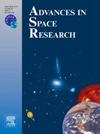Comprehensive analysis of different GNSS receivers performance based on PPP-AR and positioning accuracy during 22 geomagnetic storms in 2023
IF 2.8
3区 地球科学
Q2 ASTRONOMY & ASTROPHYSICS
引用次数: 0
Abstract
Geomagnetic storms induced ionospheric disturbances can degrade the positioning accuracy and Ambiguity Resolution (PPP-AR) of GPS Precise Point Positioning (PPP), and this negative effect varies among different GNSS receivers. Under current conditions with frequent geomagnetic storms occurrences during the peak of solar cycle 25, selecting GNSS receivers with strong resistance to ionospheric disturbances is meaningful for precise GNSS positioning and ionospheric research. Therefore, it is necessary to conduct a comprehensive comparison and evaluation of the performance for different GNSS receivers under geomagnetic storms. Based on 22 geomagnetic storms in 2023, we investigated the three-dimensional root mean square error (3D RMS) and ambiguity resolved percentage (ARP), which is defined as the ratio of the number of carrier-phase observations with fixed ambiguities to the total number of phase measurements of GPS kinematic PPP, across ten groups of collocated stations around the world. For the groups using different receiver brands, the performance ranking for positioning accuracy and PPP-AR during geomagnetic storms are as follows: TPS > JVAVD > SEPTENTRIO > TRIMBLE. The station with a larger average ARP generally has a smaller average 3D RMS error than the another GNSS station. The average 3D RMS error between collocated stations using different receiver brands is typically greater than 0.010 m and even larger. The largest 3D RMS error difference is observed between collocated stations with SEPTENTRIO and JAVAD receivers, with 3D RMS errors of 0.089 m and 0.019 m, respectively. These identical-brand receivers with different types are as follows: TPS NET-G5 > TPS NET-G3A, TRIMBLE ALLOY > TRIMBLE NETRS, SEPT POLARX5TR > SEPT POLARX5S, and LEICA GR10 > LEICA GR30, respectively. The average differences in 3D RMS and ARP can reach up to 0.021 m and 6.0 %, respectively. We found that the choice of antennas does not significantly affect PPP positioning performance during storms, with differences in average 3D RMS below 0.005 m and ARP differences below 0.2 %.. Higher latitudes have more satellites affected by ionospheric disturbances, while this effect is typically only observed during strong storms () in mid-latitudes. Adequate available GPS satellites are crucial for achieving high PPP-AR and positioning accuracy during storms. The variations of disturbed satellites and the average Rate of Total Electron Content Index (ROTI) for collocated stations are generally consistent. However, there are differences in the average of ROTI values for different receivers under geomagnetic storms. The differences in PPP-AR performance and ROTI values among different receivers under geomagnetic storms can be attributed to the variations in satellite tracking algorithms, tracking loop designs, firmware, and multipath mitigation methods used by different receivers. These findings can provide a reference value and future research direction for selection, application and enhancement for different receivers to achieve GNSS high precision positioning under complex space weather conditions.
求助全文
约1分钟内获得全文
求助全文
来源期刊

Advances in Space Research
地学天文-地球科学综合
CiteScore
5.20
自引率
11.50%
发文量
800
审稿时长
5.8 months
期刊介绍:
The COSPAR publication Advances in Space Research (ASR) is an open journal covering all areas of space research including: space studies of the Earth''s surface, meteorology, climate, the Earth-Moon system, planets and small bodies of the solar system, upper atmospheres, ionospheres and magnetospheres of the Earth and planets including reference atmospheres, space plasmas in the solar system, astrophysics from space, materials sciences in space, fundamental physics in space, space debris, space weather, Earth observations of space phenomena, etc.
NB: Please note that manuscripts related to life sciences as related to space are no more accepted for submission to Advances in Space Research. Such manuscripts should now be submitted to the new COSPAR Journal Life Sciences in Space Research (LSSR).
All submissions are reviewed by two scientists in the field. COSPAR is an interdisciplinary scientific organization concerned with the progress of space research on an international scale. Operating under the rules of ICSU, COSPAR ignores political considerations and considers all questions solely from the scientific viewpoint.
 求助内容:
求助内容: 应助结果提醒方式:
应助结果提醒方式:


